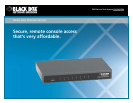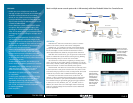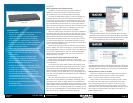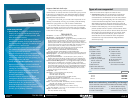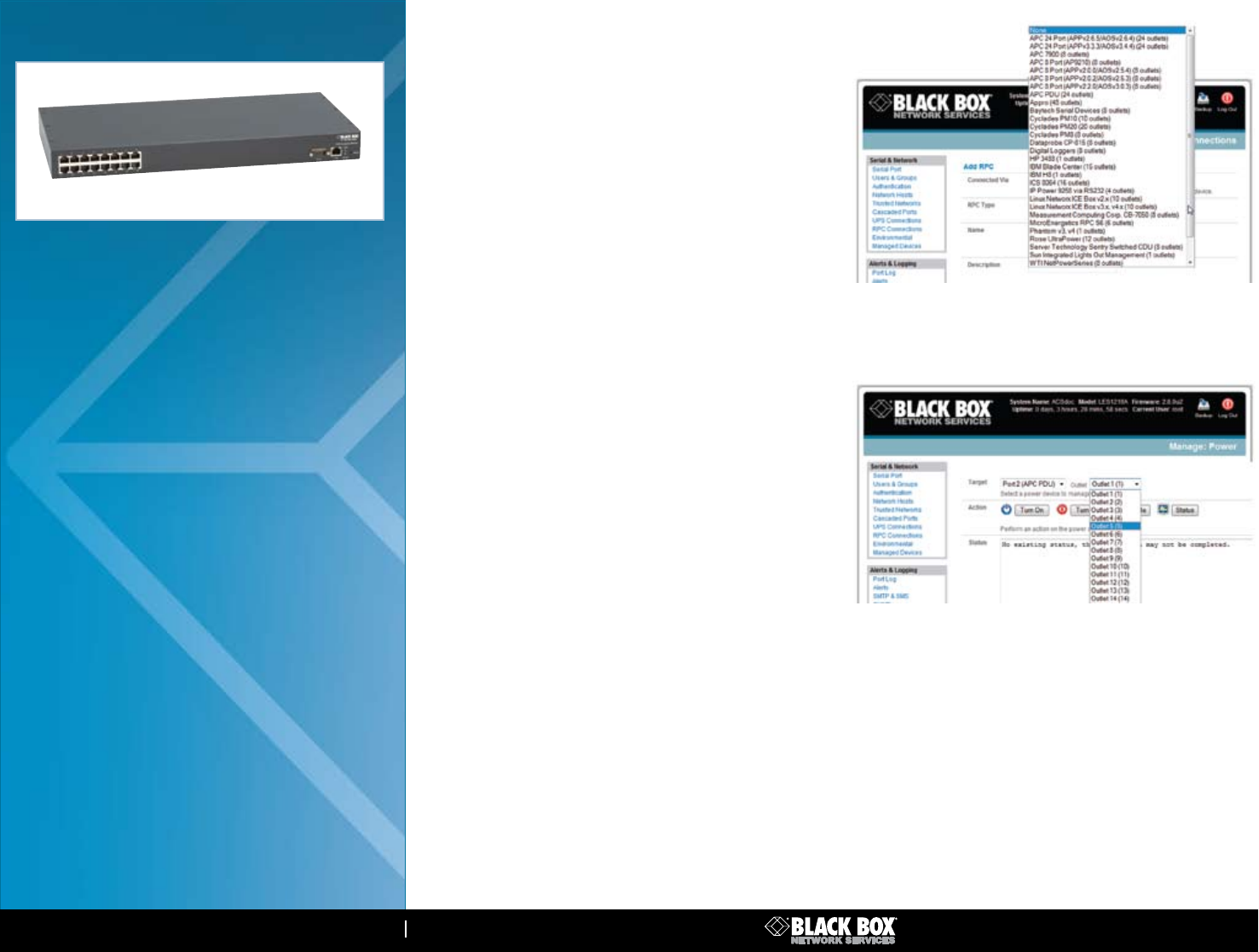
03/03/2010
#27063
724-746-5500 blackbox.com
BL A C K B O X
®
3 of 4
APPLICATIONS
In the data center, use Value Line Console Servers to:
» Simplify the management of computer,
telecommunications, and power equipment,
especially in large centers (those occupying
an entire floor or multiple floors in a building) .
» Establish in-band and out-of-band management
that meets the entire data center's local and
remote management needs.
» Better control power dissipation and make better
use of equipment space, especially in processing-
centric centers with row after row of racked
server clusters.
» Rigorously control access privileges, while
monitoring and logging all access events
to better enforce enterprise security policies.
In the SMB server room, use them to:
» Simplify the control of servers and gear racked
in a single room, especially in limited-staff offices
dealing with an expanding server count.
» Set up a single integrated gateway to locally
and remotely manage all serial- and network-
connected devices, particularly newer servers
with embedded service processors and baseboard
management controllers (BMCs).
» Set up encrypted authenticated access for local
and remote access.
» Enact better strategies for disaster avoidance.
IN DEPTH
Reach equipment out of band securely.
In addition to remote in-band access through its 10BASE-T/
100BASE-TX TCP/IP port, Value Line Console Servers support
out-of-band access to your critical equipment and vital assets.
Just attach an external dialup modem to control and manage your
distributed network of servers and other devices with the latest in
console access. Typically, you do this via Telnet software, using an SSH
tunnel through the console server to communicate securely with serial
port-connected devices over the Internet or any other public network.
But you can Telnet through the console server to the serial device several
other ways, too. (See “LAN Console Port Management” and “Serial
Console Port Management” in the Tech Specs on page 4.)
Value Line Console Servers come with an SDT Connector application.
Through this open-source SSH Java client, you auto-load your console
server’s configurations and, to ensure secure connectivity with attached
network and serial devices, set up SSH tunnels for port-forwarding
communications through the console server. The same SDT Connector
tool is also used for setting up a 10-/100-Mbps auto failover route to
a remote, out-of-band gateway. This can be through an alternate dial-in
path or out-of-band broadband path.
Robust advanced encryption keeps all connection communications
secure. In addition, the console servers give you a choice of filtering and
access logging facilities, which you can archive off-line. Store offline logs
for serial ports, available networks, and more. And to protect against
unauthorized access, the system enables you to restrict access by IP
address, password, or account.
Set up to scan the serial stream and send alerts.
To help ensure maximum uptime, Value Line Console Servers
proactively scan the serial stream on console ports, searching for specific
errors and phrases.
The console servers support SNMP and SMTP alerts/traps for serial
ports and hosts. Simply set the trigger condition for each port, and the
console server monitors port traffic for your defined character stream
pattern or phrases. If they’re detected, the console server sends SMS
text or an e-mail to you or an SNMP server (or to a central Nagios server,
if it’s used). This alerts feature can be enabled on any and all serial ports
or connected hosts.
Also, the console server informs you of its operating status. An
LED on the back of the unit flashes a “heartbeat” periodically, and its
“heartbeat monitor” agent can trigger dial-back or a redundant path
during network outages. The heartbeat monitor checks that the console
server is indeed on-line and operating as it should, that it’s clear to send
alerts and alarms, and is accessible by remote users. In addition, you can
set it up so if the heartbeat falters, it can automatically dial up a remote
site to raise an alarm, or switch to and activate a failover link.
Hotkey power on a PDU or an RPS.
A Value Line Console Server is also the ideal solution for situations
where you need out-of-band access to a “dead” communications
device—one that’s entirely locked up in a frozen condition.
Using a hotkey from the command line interface via SSH or Telnet,
you simply launch the console server’s remote power control (RPC)
menu, through which you can turn power on (or off), power cycle,
or just check the power status of a particular device. Or you activate
power status control and monitoring through SNMP. Value Line Console
Servers support thousands of PDU or RPS units, for both serial- and
SNMP-connected control.
Through a serial connection, you can access the Value Line Console
Server’s RPC menu to select your type of serial RPC device. The console
servers support most popular network and serial PDUs. And if your PDU
isn’t on the default list, then you can add support directly.
Both administrators and users can access and control serial- and network-
attached PDU power strips. You can initiate the action you want to take
by outlet, whether it’s turning it on or off, cycling, or checking its status.
LES1116A



